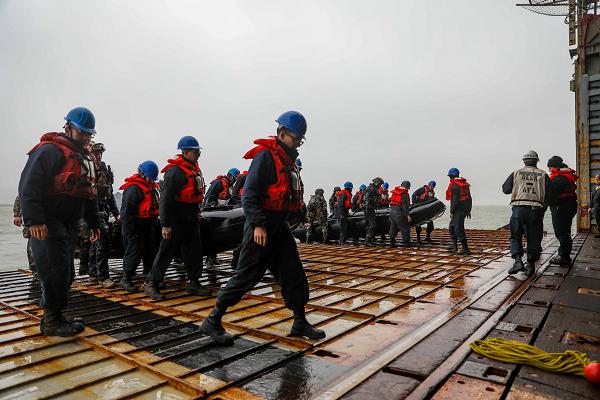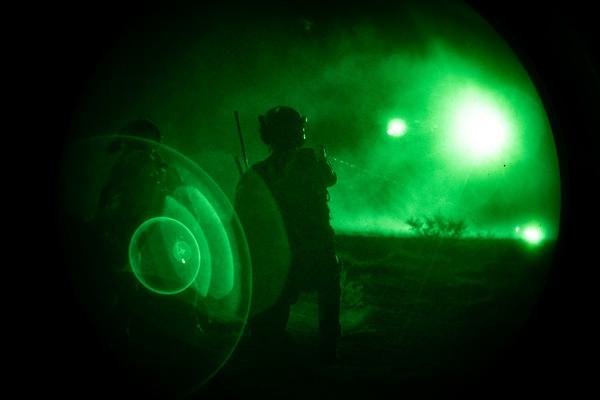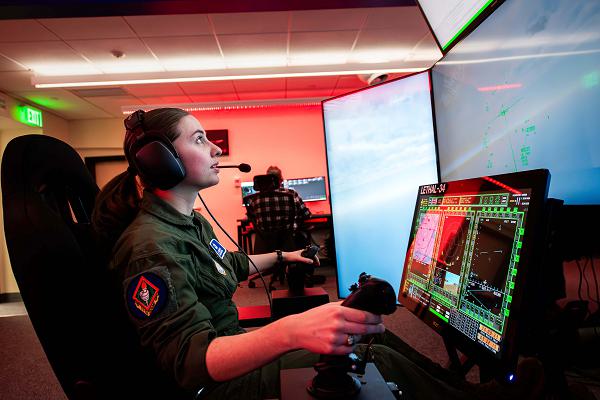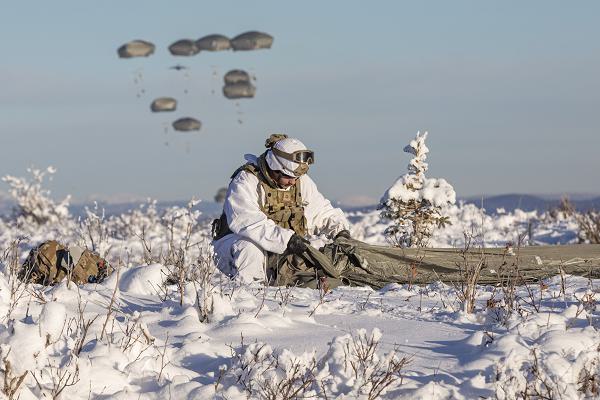- Details
- Hits: 1130

Atlantic Ocean. (February 14, 2024): In this photo by MC1 Danielle Serocki, U.S. and French Navy Sailors carry Zodiac combat rubber raiding craft off the stern gate in the well deck of the Whidbey Island-class dock landing ship USS Gunston Hall after conducting small boat operations. The French troops are from Le Bataillon de Fusiliers Marins Detroyat, or “Sailor Rifleman” that serves as security for land and coastal regions. Their mission is to protect naval vessels at sea and key sites on land and have been an integral part of the French Navy since the 1800’s.
The French and Americans are participating in Steadfast Defender 2024, the largest military exercise in Europe since the Cold War. With approximately 90,000 troops from all 31 NATO Allies, as well as new partner Sweden, participating, the exercise will evaluate NATO’s plans for reinforcing Europe against a near-peer adversary. During the event, these militaries will conduct and sustain complex multi-domain operations over several months and across thousands of miles. The exercise is strategically located in several key European countries, including Finland, Estonia, Germany, Greece, Hungary, Latvia, Lithuania, Norway, Poland, Romania, Slovakia, Sweden, and the United Kingdom.
For its part, the Gunston Hall is one of the most versatile amphibious platforms in the U.S. Navy. With two large helicopter landing pads, the largest well deck in the fleet, and spacious troop berthing facilities, Gunston Hall has the ability to embark a diverse array of military forces.
The Steadfast Defender 2024 exercises are expected to end on May 31, 2024.
- Details
- Hits: 3488

White Sands Missile Range, New Mexico. (February 18, 2024): In this photo by Sergeant Benjamin Castro, a Soldier assigned to 3rd Special Forces Group (Airborne) marks a landing zone for a CH-47 Helicopter using an infrared laser after a nighttime raid on a village. The 3rd Special Forces are participating in Sage Eagle, an annual exercise to prepare these elite troops for real world missions.
Held on the sprawling White Sands facility, the training pushes soldiers to discover their personal leadership skills while being guided by Army Green Berets and active-duty Special Forces troops. Soldiers are taught how to react to ambushes and improvised explosive devices (IEDs), booby traps, and how to evacuate casualties. Troops practice clearing rooms, entering trenches, and providing convoy security while assaulting simulated villages.
The 3rd Special Forces specialize in unconventional warfare and counter insurgency operations and often work with foreign governments on their internal defense strategies. Today, they are primarily responsible for counter-terrorism efforts in Africa.
Annual events like Sage Eagle keep our elite special forces ready to deploy to defend American anywhere, anytime.
- Details
- Hits: 840

Colorado Springs, Colorado. (February 20, 2024): The Air Force Academy held its annual Firstie Flag exercises this week to give Senior Cadets the chance to “show what they know” while making valuable contacts in their respective career fields. In this photo by Trevor Cokley, a cadet tracks incoming threats using the latest technology and under battle stress conditions. During the exercise, Cadets demonstrate their ability to work together, to solve problems “on the fly,” and to improvise solutions under realistic conditions. The goal is to prepare these cadets for future conflicts with great power adversaries. The interaction also allows these young officers the chance to meet senior practitioners of their chosen craft. It introduces first-class cadets to their future jobs and the roles they will play in a future fight.
The space operations team, for example, confronted anti-satellite missiles, co-orbital, and cyber threats and formulated plans to counter them. The team later presented their findings to the class for further discussion and brainstorming. At the same time, cadets received guidance from senior operators in their field and the opportunity to develop relationships with experts in their chosen field.
During these sessions, students met with some eighty faculty and staff, including air officers, air mobility trainers, and senior mentors from the graduate community. These contacts may prove invaluable as these Cadets graduate and serve as line officers in tomorrow’s Air Force.
- Details
- Hits: 1041

Donnelly Training Area, Alaska. (February 24, 2024): Vast sheets of ice, hurricane force winds, and temperatures of thirty below zero. Welcome to America’s “Siberia.” In this photo by Specialist Wyatt Moore, PFC David Hanson recovers a parachute after jumping onto the frozen Donnelly Drop Zone during recent Joint Pacific Multinational Readiness training held here.
This 655,000-acre training area, located a hundred miles from Fairbanks, experiences some of the most severe arctic weather on earth. In a sort of American “Siberia,” temperatures at Donnelly in the winter fall as low as thirty below with high winds whipping frozen, very rugged terrain. With America’s renewed emphasis on fighting and winning in the artic, the Donnelly facility will play a vital role due to its size and facilities.
The base has eight light maneuver training areas of over 500,000 acres and another seven reserved for heavy equipment maneuver encompassing 567,734 acres. There are additional machine gun, rifle, and pistol firing ranges and a “live fire” practice area for combined arms training. The facility also offers instruction on Nuclear, Biological, and Chemical defense including a “gas chamber” where troops experience (safely) the effects of a chemical agent. Donnelly is also the host to major maneuvers including Air Assault, Airborne (including establishing landing zones), and various ground units that must operate in an arctic environment.
Thanks to the Donnelly Training Area, American troops will be ready to fight and win in the Arctic.
- Details
- Hits: 2032

White Sands, New Mexico. (February 19, 2024): As far back as World War II, American airmen downed behind enemy lines had to learn how to evade the enemy and survive. In this photo by 2nd Lieutenant Merit Davey, Survival, Evasion, Resistance, and Escape (SERE) specialists and Explosive Ordnance Disposal technicians from the 27th Special Operations Wing hold exercises on Melrose Range, New Mexico. The training centers on the “survive and return with honor" concept with a curriculum that includes survival skills, evading capture, the military code of conduct, and techniques to escape from captivity. SERE is taught to a variety of personnel based on their risk of capture and potential exploitation value to the enemy. This is particularly the case for aircrew, special operators, and foreign diplomatic or intelligence personnel.
Each year, approximately 1,500 Soldiers, Airmen, and Marines come to the Special Operations Forces Training and Experimentation Center here to experience what it is like to be a prisoner of war. At White Sands, units are able to conduct irregular warfare activities in an environment that replicates the modern-day battlefield.
The survival school teaches unique skills such as specialized signaling, vectoring a helicopter to their position, and how to use rescue devices like forest penetrator harnesses. Other survival skills include building fires, erecting crude shelters, procuring food, and locating safe drinking water. For meat, students practice setting traps or snares to capture rabbits, snakes, or other wild edibles.
- Details
- Hits: 924

Villamor Airbase, Philippines. (February 11, 2024): Displaying their softer side, American Marines came to the rescue of thousands of Filipinos effected by recent severe flooding and landslides. In this photo by Sergeant Savannah Mesimer, Marines with Aerial Refueler Transport Squadron 152, 1st Marine Aircraft Wing, alongside Philippine military and coast guard service members palletize Department of Social Welfare and Development aid for distribution.
The February floods affected 1.7 million people, displaced at least 300,000, and damaged or destroyed 1,600 houses. The resulting landslides caused up to ninety deaths with another fifty people missing. Many of these casualties occurred because of a landslide triggered by rainfall in the gold-mining Barangay of Masara, Davao de Oro province.
At the request of the Government of the Philippines, the III Marine Expeditionary Force (III MEF) rapidly transported 15,000 family food packs - ensuring over 75,000 people devastated by catastrophe had access to life sustaining assistance. Working with the U.S. Agency for International Development, the III MEF conducted ten support missions to deliver much needed supplies using its KC-130J Hercules aircraft. The 27,000 members of the III MEF are forward based in Japan which allows the Marines to move quickly to support allies in time of need.


